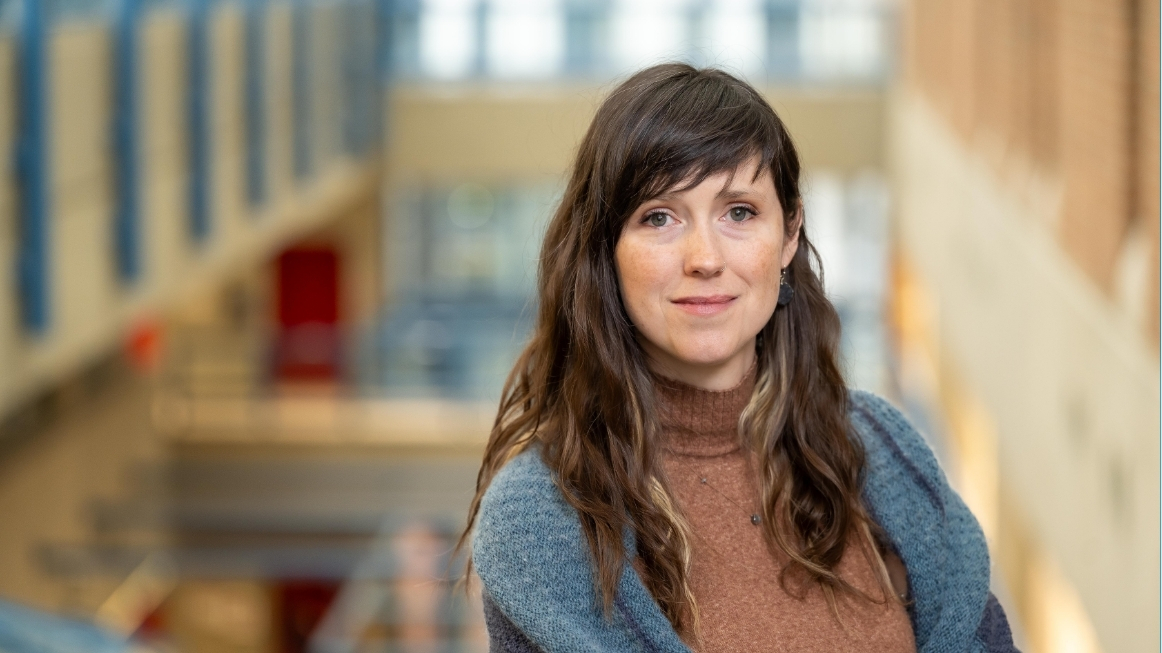

Dr. Jiaying Zhao at a UBC recycling station. Photo: UBC Sustainability Initiative, Joao Correa.
This article was written by Patti Ryan for the Canada Foundation for Innovation. Read the original article.
Like most of us, Jiaying Zhao is familiar with the idea that if we don’t control the climate crisis, the Earth may reach a tipping point beyond which irreversible ecological damage looms. Increasingly extreme weather events in her home province of British Columbia over the past decade — severe wildfires, a heat dome, a tornado, atmospheric rivers causing devastating floods — have delivered some fairly tangible supporting testimony.
They’ve also fuelled her interest in studying why, despite the evidence, some people continue to refute the existence of climate change and the need to act on it.
According to an article Zhao co-authored, more than 97 percent of climate scientists agree that human activities are warming the planet, and more than 80 percent of Canadians who identify as politically liberal believe the science. Yet almost two-thirds of conservative voters report being disbelievers. Zhao, a psychology professor at the University of British Columbia , studies what might explain the divide — and how we can respond.
Climate change beliefs are a polarizing issue
With CFI-funded equipment, including eye-trackers and virtual reality headsets, Zhao has been exploring how participants across the political spectrum react when shown evidence of climate change. So far, she has found that liberal individuals show heightened attention to the issue, while politically conservative individuals become more distanced and skeptical.
For example, when shown a graph of global temperature change over time, liberals paid more attention to the rising phase of the curve while conservatives focused more on the flat phase.
In a subsequent experiment, Zhao and her team coloured the graph to emphasize either the rising or flat phase. When the rising phase was highlighted, liberals were more likely to sign a petition or donate to an environmental organization — but conservative participants were less likely.
What this tells us is that people’s beliefs influence what they see and guide their decisions, says Zhao. “For conservative individuals, it was more like, ‘Don’t show me something I don’t believe in,’” she says. “Not only are they not persuaded — they will push back.”
This indicates a need to tailor communication strategies, says Zhao, rather than relying on a one-size-fits-all approach. “For conservatives, maybe you use a different messenger — so rather than a researcher or scientist, maybe a conservative or religious leader, someone they trust, respect and look up to.”
Taking action that makes you happier
Zhao points out that the narrative around climate change has tended to be one of shame, guilt and sacrifice. Some people feel overwhelmed by the scale of the problem and respond by ignoring the need for action or rejecting climate science altogether.
Cognitive dissonance — the mental conflict that occurs when your beliefs and actions are out of sync — may be at play: if you believe the climate science, but find it too hard to change, you live in a constant state of low-grade mental discomfort. But if you reject the climate science, then you can generate all the carbon you like, free from cognitive dissonance or discomfort.
“So part of my research involves asking: How can we turn climate action into something rewarding that makes people feel happy?” says Zhao. “For example, instead of shaming people for driving, focus on the positives of cycling: you’re getting exercise, you’re out in nature, you’re saving money.”
To pursue this idea, Zhao teamed up with social psychologist Elizabeth Dunn, a UBC colleague who studies happiness. The two developed Happy Climate, a free online workshop that teaches people how to reduce their carbon footprint through actions that make them happier.
Zhao and Dunn hope to test whether this approach can lead to lasting behaviour change on a societal level. The idea is that the workshop may shift social norms as people model the behaviours it inspires.
“This is looking at behavioural change at the individual level and trying to generate a groundswell, as opposed to changing things from a policy or collective level,” says Dunn. “We hope to find a spillover effect — that when people make personal changes to reduce their carbon footprint, they are more motivated to demand climate policies from governments, businesses and institutions.”
In the psychology of climate change, there are six types of people
To better understand what drives different types of people to take climate action, Zhao has proposed an approach that organizes individuals into different groups based on the Global Warming’s Six Americas framework, which was developed by researchers in the U.S. to inform climate change communications. On the left is a group she calls the change makers. Driven by environmental values, these individuals are spearheading the fight against climate change.
Next in the line are the early adopters of climate actions (who want to be seen as leaders), then the early majority (who are interested in personal benefits of action and will emulate early adopters), the late majority (who will take climate action mainly to fit in with society), and finally the so-called laggards. Members of this last group are not only unconvinced about the need for climate action, but about the reality of climate change itself. They will only act to avoid social or legal consequences.
Each group is motivated by different forces — but as long as they all respond, change is still possible. To prevent the worst effects of climate change, says Zhao, practitioners, researchers and policymakers may need to understand these dynamics and tailor interventions to different groups of people.
ABOUT






